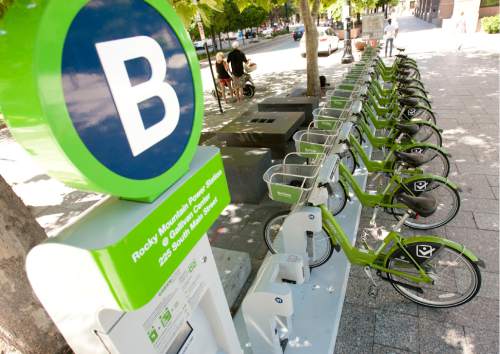This is an archived article that was published on sltrib.com in 2016, and information in the article may be outdated. It is provided only for personal research purposes and may not be reprinted.
With the Wasatch Front's population projected to nearly double by 2050, some unusual methods to help handle the resulting extra traffic are now under consideration.
That includes the possibility of free or low-fare transit in the future and perhaps a "bicycle superhighway" away from motorized vehicles to allow more and easier commutes by cyclists along the Interstate 15 corridor.
The Utah Transportation Commission got a sneak peek Friday at some innovations being considered in a study about future transportation along the Wasatch Front's central corridor — which essentially follows I-15.
The Utah Department of Transportation, Utah Transit Authority, Wasatch Front Regional Council and Mountainland Association of Governments are working on the study, aided by an $820,000 federal grant, but it is still in its early stages.
"We're going to have a lot more people," Lisa Zundel, a UDOT project manager told the commission. "We don't have a lot of space geographically. We are constrained by mountains and lakes," so simply adding more and bigger highways is not an option to handle all future transportation needs created by the growing population.
She listed some innovations that the study is considering.
"We're looking at subsidizing transit fares to reduce or make those fares free" for buses and trains, she said. That could reduce traffic on the roads.
Also included is "electrifying and double-tracking FrontRunner, as well as adding additional FrontRunner stations" for that commuter rail system.
FrontRunner now runs on single tracks in many stretches, which limits the frequency of trains because careful timing is needed so they may pass each other in double-tracked areas and stay on schedule. FrontRunner also uses diesel engines. Switching to electricity could cut operation costs and air pollution.
Zundel said planners also are considering "pay-per-use mobility kiosks," which may offer short-term rentals at transit stops for bikes, scooters or small electric cars. They would help commuters who want to use transit but perhaps face walks to their final destinations that are too far away.
The idea is similar to, but more expansive than, Salt Lake City's GREENbike system. "It's like a Redbox for transportation," Zundel said, offering "a kiosk to rent transportation to get you where you want to go for a few hours or a day."
Another example of innovations being considered is "what we're terming a cycle superhighway," Zundel said.
"It's also been called a 'cycle autobahn,' which allows the cyclists that are specifically wanting to commute to be away from vehicles" to enable more and easier trips.
UDOT Executive Director Carlos Braceras told the commission the new study is much different than those of previous years, which mostly tried to figure what new highways to build or which roads needed widening — although those remain part of this study.
"It is very comprehensive. It is recognizing that this next long-range plan will be quite different than in the past," Braceras said, adding that current projects to widen freeways are just "temporary fixes" toward handling long-term growth.
Zundel said planners will work with elected officials and technical staff at cities and transportation agencies through the summer about possibilities, and plan to present various possible scenarios for public comment by year's end.





